Agua entre la metalurgia
(Water in between metallurgy)



Mentored by Alana Hernandez
Presented by CUE Art Foundation
137 West 25th Street
New York, NY 10001
 All artwork © Carolina Aranibar-Fernández
Photos by David Michael Cortes and Leo Ng
CUE Art Foundation
All artwork © Carolina Aranibar-Fernández
Photos by David Michael Cortes and Leo Ng
CUE Art Foundation
Carolina Aranibar-Fernández
January 19 — March 11, 2023
CUE Art Foundation
Exhibition Mentor:
Alana Hernandez
Catalogue Essayist:
Angelica Arbelaez
Essay Mentor: Max Pearl
Detail of Las memorias de las huellas (The memories of thumbprints), 2022
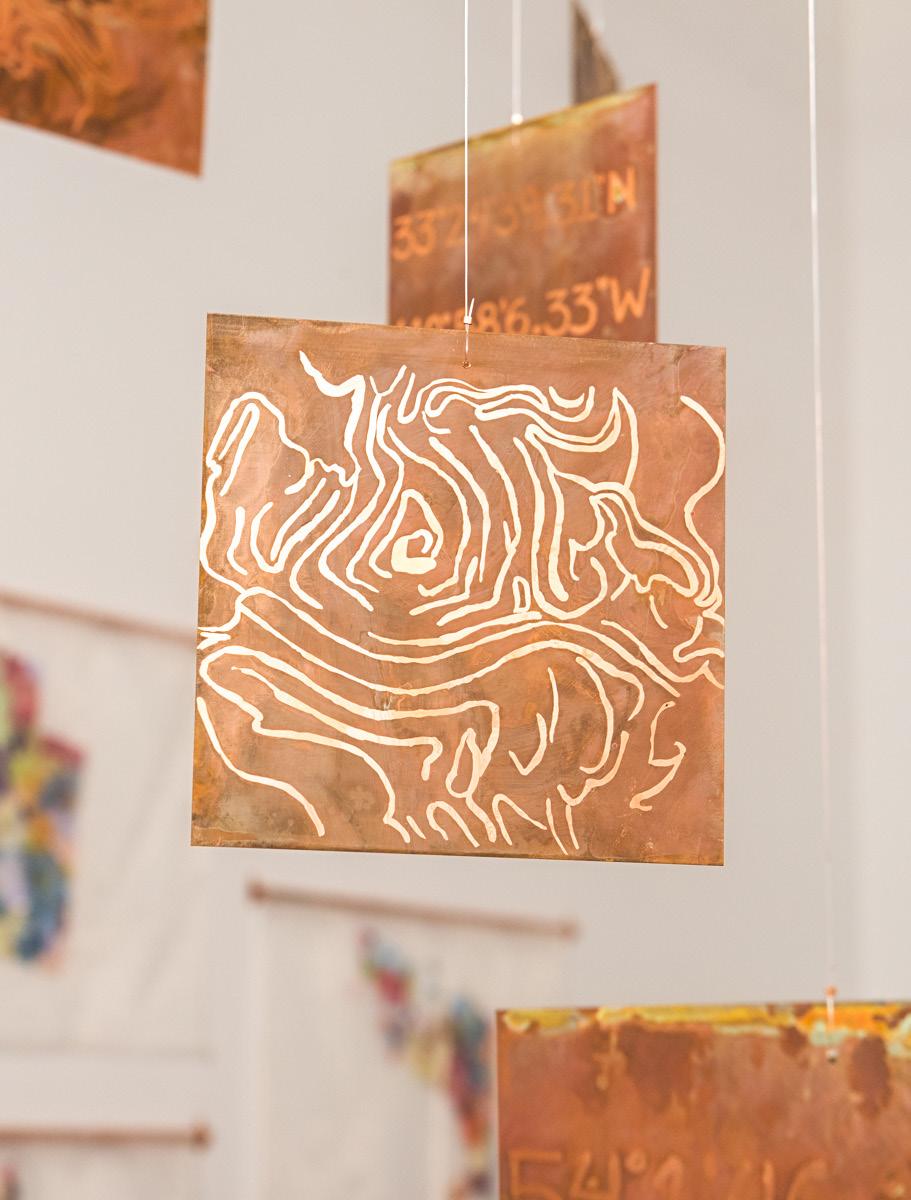
Agua entre la metalurgia (Water in between metallurgy) is a solo exhibition by Carolina Aranibar-Fernández with curatorial mentorship from Alana Hernandez. The exhibition builds upon the artist’s ongoing practice that addresses the geopolitical concerns of exploitation. Through works that incorporate processes of etching, sewing, stitching, cutting, and printing, Aranibar-Fernández seeks to deconstruct complex movements of resources on a global scale.
Utilizing the language of maps, charts, and aerial topographies, Agua entre la metalurgia repositions seemingly neutral tools of knowledge and information that are often seeded with the biases of colonialism and imperialist power. Instead of rendering her works in pen and paper or vector and screen, Aranibar-Fernández constructs them with copper, sequins, silver thread, and embroidery, the latter repurposed from shawls worn by Aymara women in Bolivia, where she was born and raised.
In materially referencing the dynamics of natural resource control and the invisible labor embedded in global trade, the works provoke a consideration of exploitation that simultaneously centers land, labor, and—crucially—people. “These works, at points disquieting in their glittering opulence,” writes exhibition mentor Alana Hernandez, “underscore the ongoing threat of colonization, genocide, and displacement faced by Indigenous populations.”
Agua entre la metalurgia is Aranibar-Fernández’s first solo exhibition in New York City, and comes on the heels of a residency at the Phoenix-based CALA Alliance. There, she expanded upon previous works that trace the flows of trade through water, exploring routes such as those that brought the luminescent fabric flowers of her source material from South China through the Philippines to Bolivia. While in Phoenix, she also began to take note of the historiographies of copper mining in Arizona, reflecting upon the similar impacts of its economic extractivism—forced migration, oppression, and loss—on populations across South America.
Agua entre la metalurgia presents new works that result from this layered reflection, as AranibarFernández traces active mining sites and etches them onto copper plates with acid, each forming a unique thumbprint of destruction. In witnessing them corrode with the passage of time, we are invited to consider a key question: what scars will we allow to be burned into the earth…and onto our memory.
 Installation view: Agua entre la metalurgia
Installation view: Agua entre la metalurgia
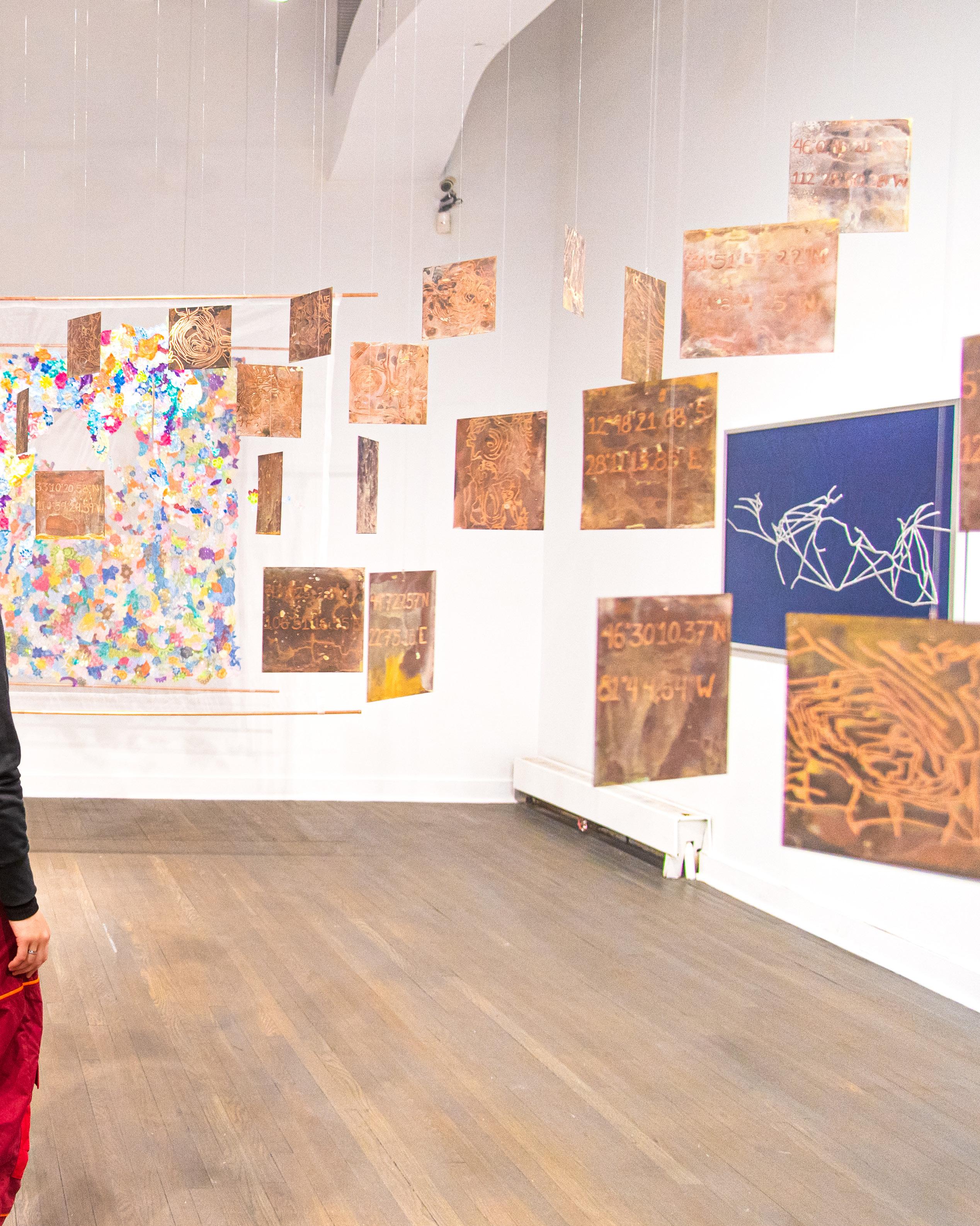
Through my work, I am interested in addressing concerns such as displacement, privatization of land, exploitation of natural resources, environmental issues, and the invisible exploited labor that supplies global trade. In my installations and objects, I interweave fabrics, oral storytelling, ceramics, and video, using hand making processes and materials drawn from both ancestral and contemporary crafts. I explore materials as a language, treating them as non-verbal stories. I allow materials like soil, sugar, metals, crude oil, and others to be the storytellers in my work.
My installations, objects, and performances are informed by research into the histories of resource extraction and the oppressive labor systems that have fueled the ideologies of colonization and capitalism, from slavery to mass incarceration. My practice examines visible and invisible borders, and the displacement of bodies across land and water as a result of the exploitation of resources and labor that corporate capitalism continues to profit from. I center oral histories, ancestral ways of knowledge and healing in my work, and seek to offer participatory experiences for the viewer.

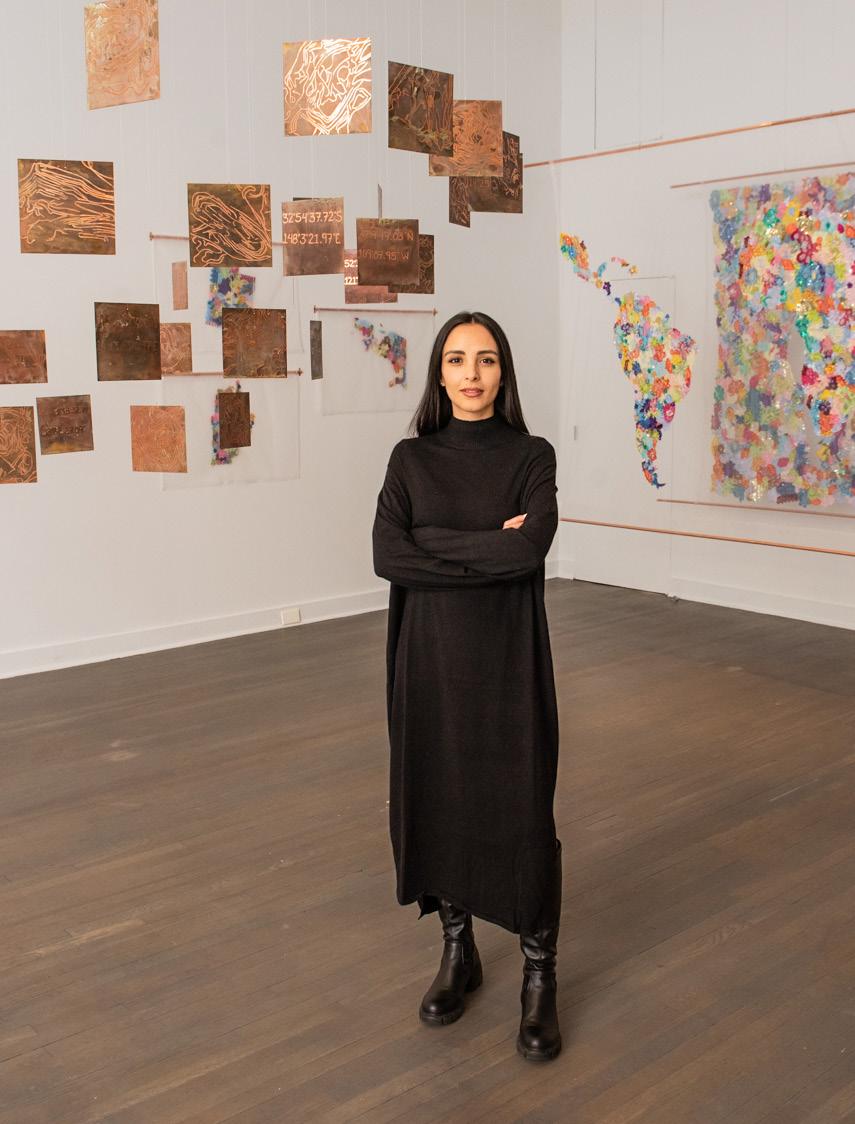 Carolina Aranibar-Fernández. Photo: David Michael Cortes.
Carolina Aranibar-Fernández. Photo: David Michael Cortes.
Carolina Aranibar-Fernández (b. 1990) is an interdisciplinary artist born and raised in La Paz, Bolivia who currently lives and works in San Francisco, CA. Aranibar-Fernández received an MFA from Virginia Commonwealth University and a BFA from the Kansas City Art Institute. She has exhibited at the ASU Art Museum, Tempe, Arizona; the National Museum of Art, La Paz, Bolivia; The Albright Knox, Buffalo, New York; Praxis Gallery, New York; and the 2017 Kathmandu Triennale, Nepal.
Aranibar-Fernández was a Race, Arts & Democracy Fellow at the Center of Study of Race, Arts, and Democracy at Arizona State University (2020–2021) and a Regional Resident for CALA Alliance in Phoenix, Arizona (2021). Other past fellowships and residencies include: the Binational Arts Residency (2019–2020), the Projecting All Voices Fellowship at the Herberger Institute for Design, Arizona State University (2018–2019), and a fellowship at Virginia Commonwealth University in Qatar (2016–2017).
Las memorias de las huellas (The memories of thumbprints), 2022


I first met Carolina Aranibar-Fernández in Phoenix when she was in residency at CALA Alliance as our first regional resident. Carolina proposed a project related to mapping the displacement of bodies and resources across geographies, particularly in South America and non-Western contexts. She painstakingly hand-sewed black beads and fishing line onto opaque tulle, which hung from copper pipes. That project, in a similar vein to this presentation at CUE, mapped trading routes and movements across land and water.
For Agua entre la metalurgia, Carolina’s first solo exhibition in New York City, the Bolivian-born multidisciplinary artist addresses urgent geopolitical concerns related to the extraction and exploitation of labor, and uncovers the historical origins of these contemporary practices. The artist charts the flows of capital through cartographic renderings of maritime trade, cash crops, and industrial metals across the expansive bodies of water, often referencing the Indigenous bodies that move it.
Carolina has aptly conceived this exhibition as ongoing research into disrupting the cartographies of extracted resources, creating several new works that detail how contemporary markets insidiously mask historical oppression. Taking a myriad of forms, her project at CUE employs hand-sewn or embroidered maps, etched copper plates, and prints that each reference the merciless mining and extraction of the earth.
These works, at points disquieting in their glittering opulence, underscore the ongoing threat of colonization, genocide, and displacement faced by Indigenous populations. Carolina’s unwavering interest in exposing the ongoing extraction happening to our environment implores us as visitors to learn and engage with these treacherous, often-hidden histories. The works on view chart these various displacements, mapping a global web of interconnection and responsibility from Phoenix to New York, to Bolivia and beyond.
 Detail of Las memorias de las huellas (The memories of thumbprints), 2022
Detail of Las memorias de las huellas (The memories of thumbprints), 2022

Alana Hernandez is Executive Director & Curator of CALA Alliance (Celebración Artística de las Américas). As Executive Director, Hernandez fosters Latinx/e artistic talent in the Metro-Phoenix region and beyond. In her time at CALA Alliance, she has organized the exhibitions Carolina AranibarFernández: El desplazamiento y las flores (2022) and Sam Frésquez: Second Place is the First Loser (2022). Her most recent exhibition, A pattern, a trace, a portrait: Four artists from CALA Alliance’s Residency Program, opens to the public at the ASU Art Museum in January 2023.
Hernandez has held curatorial positions at the Museum of Contemporary Art San Diego; Whitney Museum of American Art, New York; Páramo, Guadalajara, Mexico; Hunter East Harlem, New York; the Museum of Modern Art, New York; the Phoenix Art Museum; and BRIC Arts Media, Brooklyn. Her writing has appeared in MCASD.Digital (2021), HereIn Journal (2020), the exhibition catalogues
Carolina Aranibar-Fernández: El desplazamiento y las flores (2022); Gabriel Rico: Unity in Variety (2021); John Rivas: Las Voces Inside Me (2020); Atlpan: Claudia Peña Salinas (2019); and Traveler Artists: Landscapes of Latin America from the Patricia Phelps de Cisneros Collection (2015).
Hernandez is also a contributor and organizer of Museum of Contemporary Art San Diego: Handbook of the Collection (2021) and three-print volume, Grove Encyclopedia of Latin American Art and Architecture. She received an MA from CUNY Hunter College, where she specialized in Modern and Contemporary Latin American Art.
 Installation view: Agua entre la metalurgia. Photo: David Michael Cortes.
Installation view: Agua entre la metalurgia. Photo: David Michael Cortes.

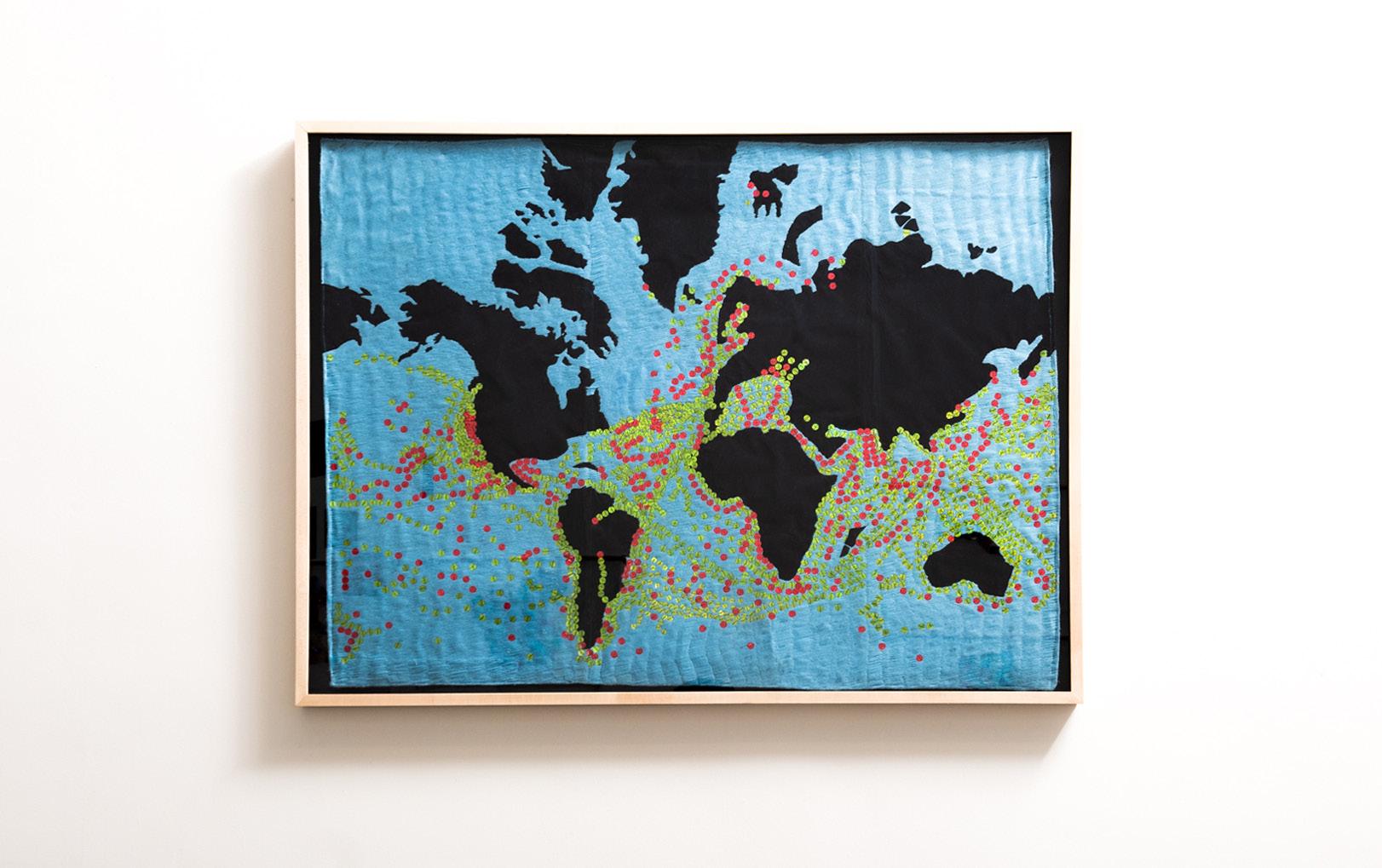

In the exhibition Agua entre la metalurgia (Water in between metallurgy), Bolivian artist Carolina Aranibar-Fernández considers the scale and impact of the global mining industry through poetic and labor-intensive material gestures. Engaging primarily with textiles and copper, the artist uses embroidery and printmaking to create maps and aerial topographies that visualize typically unseen mining-related activities. The extraction of geological matter from the earth, its trade, and its eventual consumption have generated a circuit of capitalistic interest that relies on the availability of natural resources and human labor—primarily from Black, Brown, and Indigenous people. Aranibar-Fernández uses cartography not only to give these dynamics a visual and tangible form, but also as an instructive tool to acknowledge the parallel strain placed on human and terrestrial bodies.
The artist’s insights into mining are based on rigorous studies of its history, economy, and politics. Her exploration began with Cerro Rico, the infamous mountain in the city of Potosí, Bolivia that became a lucrative silver mine for the Spanish Empire in the 16th century. The “mountain that eats men,” as it’s colloquially referred to, has been continually mined for centuries, resulting in incalculable human loss and irreversible ecological damage. [1]
Through site visits, archival research, and the firsthand accounts of local mine workers, Aranibar-Fernández began to see Cerro Rico as a blueprint for modern mining. This led her to see connections with colonial and industrial histories in other parts of the world, including the American Southwest and Indonesia, both of which she explores in this exhibition.
Agua entre la metalurgia features six bodies of work that unmask the mining industry’s neocolonial role as an agent of ecological disaster. In lieu of a didactic message, however, the artist weaves these ideas into beautiful, vibrant, and delicate works of art. They carry a softness which is antithetical to the violence and destruction that are characteristic of the practices and histories to which they refer. The artist purposefully cultivates this tension as a way to draw viewers in and encourage conversations on a topic they might otherwise cast aside. As a result, the works are sites where a sobering awareness of our world’s ills can be met with empathy and compassion.
Water Labor (2019-21) depicts a hand-embroidered world map featuring dense clusters of red and green sequins. These small embellishments represent the positions, routes, and movements of shipping containers and bulk carriers transporting commodities across the globe. For this work, Aranibar-Fernández consulted the website MarineTraffic to see live coverage of international maritime activity. [2]
Using a combination of satellite imagery and information from coastal AIS receiving stations, MarineTraffic offers an impressive view of the cargo ships, tankers, pleasure crafts, and commercial fishing boats actively moving throughout the world.
The animated swarm of sequins in Water Labor takes on a parasitic character, overwhelming and infiltrating the withering continents rendered in a dark velvet. They also illustrate the relatively unseen movements of raw materials from their
sites of extraction to succeeding sites of trade and consumption. Aranibar-Fernández adopts the coherent design strategies of data visualization in order to track, map, and make sense of this dizzying concentration of activity and the scale at which it operates. While the word “labor” in the work’s title undoubtedly refers to the human and machine work that drives the industry, it’s also reflected in the painstakingly hand-embroidered ocean that serves as the work’s background.
In Silver Labor (2019-21), the artist uses mapping techniques to trace the paths of silver around the world, but with a more abstract approach. By framing the striking silver routes against a sea of dark blue velvet fabric, Aranibar-Fernández removes any obvious representational references to maps. The formal simplicity of this line work invites other associations: a network of tunnels in a mine, the branches on a tree, or veins in a body. It suggests that extractivism continues even after the unearthing: silver changes hands many times as it makes its way from the miner who collected it to our tableware, jewelry, and mirrors. In Silver Labor, mapping is both a tool for viewers to locate themselves along this supply chain and a way of showing connections between bodies across vast distances.
For this exhibition, Aranibar-Fernández produced two new works featuring fabric flowers that were individually cut from women’s shawls and then sewn together by hand onto diaphanous pieces of tulle. Together, these flowers are used to create maps of specific countries and different regions throughout the world. The installation Los testimonios de las flores (The testimonies of flowers) (2022) consists of two large layers of the aforementioned flower maps: the first is a positive image depicting countries in Central and South America, Africa, the Middle East, and Asia; the second is a negative image of those same regions. The top and bottom edges of each component are bordered by copper rods that are used to suspend the work from the ceiling. The layers are positioned four feet away from each
other, allowing visitors to walk between them. When standing in front of the work, at a distance, the two maps almost become a single vibrant bed of flowers.
As the title suggests, Los testimonios de las flores is a testimony, a presentation of evidence. Historically, many of the countries depicted in this work have been subject to extraction, plunder, and oppression through colonization—mainly at the hands of the countries not represented. The artist refers to these countries collectively as the Global South, a concept that’s been criticized for omitting certain geopolitical subtleties. But when discussing the work, she asserts the term’s usefulness as a way of appreciating the colonial histories these countries share. “These are the places that are constantly sought out for their resources, but don’t benefit economically,” she said. [3]
The Cartografia (Cartography) series (2022) includes nine individual flower maps portraying the following locations: Antofagasta, Chile; Gobi Desert, Mongolia; Kabwe, Zambia; Nevada, USA; Papua, Indonesia; Para, Brazil; Sakha, Russia; Sewell, Chile; and Utah, USA. Each of these places is also home to various open-pit copper, lithium, and silver mines. As in Los testimonios de las flores, the maps are also made of individually cut fabric flowers that are hand sewn on delicate sheets of white tulle. For each Cartografia, Aranibar-Fernández has added an additional layer of tulle with a nearly imperceptible linocut print of the topography of each open-pit mine seen from above. Here, the relationship of presence and absence is expressed again. The sections of land are decorative, captivating, and become the central focus of the work, but the actual effects of the activity imposed on them are veiled, obscured, and unseen. In this work, the geological impact of these activities is as conspicuous as the shroud of obfuscation that keeps the public from finding out.
While living in Phoenix, AZ, Aranibar-Fernández began researching the Arizona-based mining company Freeport-McMoRan, owner of some of


Detail of Las memorias de las huellas (The memories of thumbprints), 2022

the world’s largest copper and gold mines. Cicatriz (Scar) I, II, and III (2021-22) are linocut prints on cotton paper that were made in response to the artist’s findings. Each print is an aerial view of three different open-pit mines operated by FreeportMcMoRan located in Chile, Indonesia, and Peru. When the artist produced the prints, she scattered copper powder on top of the ink while it was still wet to create an iridescent effect. Open-pit mines are created using surface mining methods to extract rock, minerals, or metals from the earth. The results of such activity are literally and metaphorically profound. They are colossal cavities in the earth that are organized by levels, similar to benches in an arena, as miners descend deeper into the ground. In each Cicatriz, the artist intentionally creates a parallel between the excavation of the earth and the carving that is necessary to manipulate the linoleum surface.
In Las memorias de las huellas (The memories of thumbprints) (2022), sixty-one copper plates that are etched with acid hang from the ceiling in alternating heights to echo the various levels of an open-pit mine. On each plate is an aerial topography of a single mine on one side and the GPS coordinates of that specific site on the other. The line work seen in the topographic drawings is serpentine, forming loose concentric circles. When seen from above, these drawings bear a resemblance to gashes, fingerprints, or the rings of a tree trunk. The artist welcomes the inclination to anthropomorphize these forms and draw parallels to the natural world. In her estimation, it keeps the work grounded in a corporeal reality that engenders a more visceral response to what mining does to the earth. It encourages the question: could these terrestrial wounds be my own?
In addition to the numerous bodily parallels one can project onto open-pit mines, their contours and their visual logic also emulate ripples, a metaphor that gets at the conceptual heart of Agua entre la metalurgia. Small waves turn into larger ones as they stretch far beyond their point of origin, mirroring the flow of people and things as they pass through
processes of extraction, trade, and consumption. In the hands of Aranibar-Fernández, maps are useful for visualizing and tracking these patterns, but more so, they’re tools for understanding the inner workings of power in visceral, corporeal terms. Though the effects of these cycles may feel distant, the artist insists that they’re much closer than we know.
[1] Forero, Juan. “Bolivia's Cerro Rico: The Mountain That Eats Men.” NPR. September 25, 2012. [https://www.npr.org/2012/09/25/161752820/ bolivias-cerro-rico-the-mountain-that-eats-men]
[2] MarineTraffic [https://www.marinetraffic.com/]
[3] Conversation with the artist on December 28, 2022
Angelica Arbelaez is an independent curator and researcher from Miami, Florida. Currently, she is the inaugural Rubio Butterfield Family Fellow at the Whitney Museum of American Art. She was previously the Programs Manager at Oolite Arts from 2017-2020, and the Communications and Events Manager at Locust Projects from 2014-2017. She holds an MA from the Center for Curatorial Studies, Bard College, and a BA in Art History from Florida International University.
Max Pearl served as a writing mentor for this essay. Max is a writer and translator based between the US and Mexico.
This text was written as part of the Art Critic Mentorship Program, a partnership between CUE and the AICA-USA (US section of the International Association of Art Critics). The program pairs emerging writers with art critic mentors to produce original essays about the work of artists exhibiting at CUE's gallery space. For more information about the program, visit the ACMP page on CUE's website at www.cueartfoundation.org. No part of this essay may be reproduced without prior written consent from the author.
 Installation view: Agua entre la metalurgia. Photo: David Michael Cortes.
Installation view: Agua entre la metalurgia. Photo: David Michael Cortes.
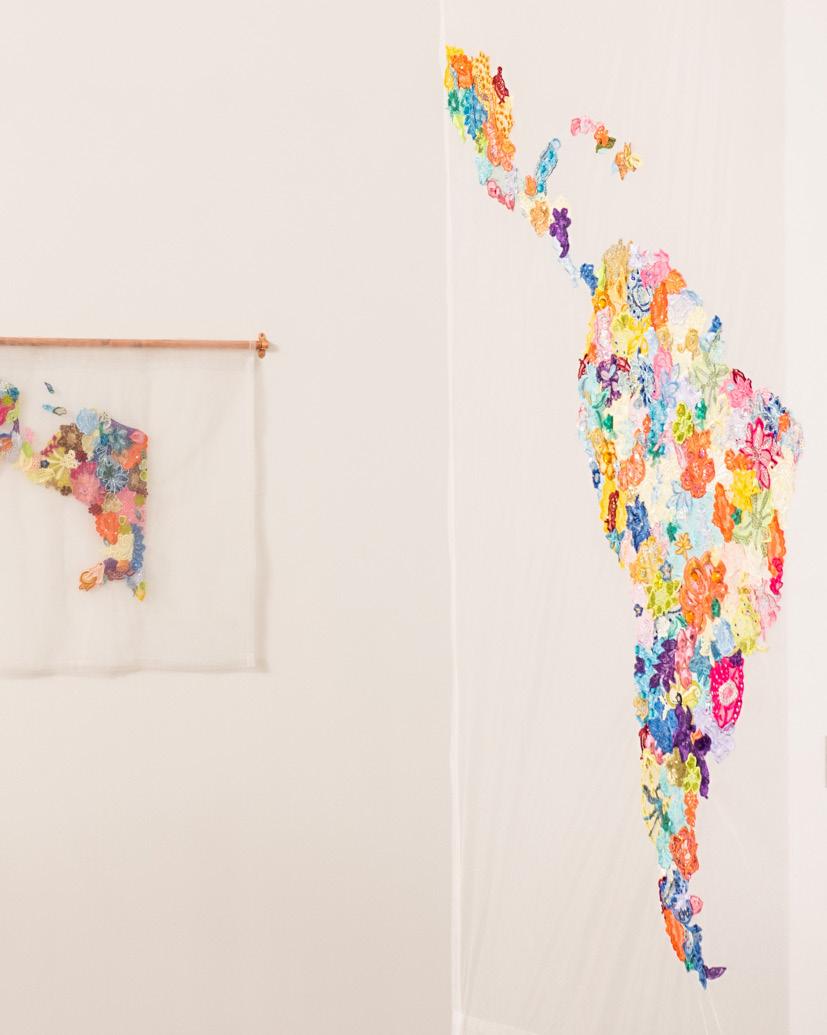
 Installation view: Agua entre la metalurgia.
Photo: David Michael Cortes.
Installation view: Agua entre la metalurgia.
Photo: David Michael Cortes.

CUE Art Foundation is a nonprofit organization that works with and for emerging and underrecognized artists and art workers to create new opportunities and present varied perspectives in the arts. Through our gallery space and public programs, we foster the development of thoughtprovoking exhibitions and events, create avenues for mentorship, cultivate relationships amongst peers and the public, and facilitate the exchange of ideas.
Founded in 2003, CUE was established with the purpose of presenting a wide range of artist work from many different contexts. Since its inception, the organization has supported artists who take risks that challenge public perceptions, as well as those whose work has been less visible in commercial and institutional venues.
Exhibiting artists are selected through two methods: nomination by an established artist or selection via our annual open call. In line with CUE’s commitment to providing substantive professional development opportunities each artist is paired with a mentor, an established curator or artist who provides support throughout the process of developing each exhibition.
To learn more about CUE, visit us online or sign up for our newsletter at www.cueartfoundation.org.
Programmatic support for CUE Art Foundation is provided by Evercore, Inc; ING Group; The Milton and Sally Avery Arts Foundation; The William Talbott Hillman Foundation; and Corina Larkin & Nigel Dawn. Programs are also supported, in part, by public funds from the New York City Department of Cultural Affairs, in partnership with the City Council; the New York State Council on the Arts with the support of Governor Kathy Hochul and the New York State Legislature; and the National Endowment for the Arts.

Carolina Muñoz Awad Gallery Associate
Maryam Chadury Programs
CoordinatorRiki Lorenzo Development & Communications Intern
Leo Ng Development & Communications Intern
Theodore S. Berger, President
Kate Buchanan, Vice President
John S. Kiely, Co-Treasurer
Kyle Sheahen, Co-Treasurer
Lilly Wei, Secretary
Amanda Adams-Louis
Marcy Cohen
Blake Horn
Thomas K.Y. Hsu
Steffani Jemison
Vivian Kuan
Aliza Nisenbaum
Gregory Amenoff, Emeritus
